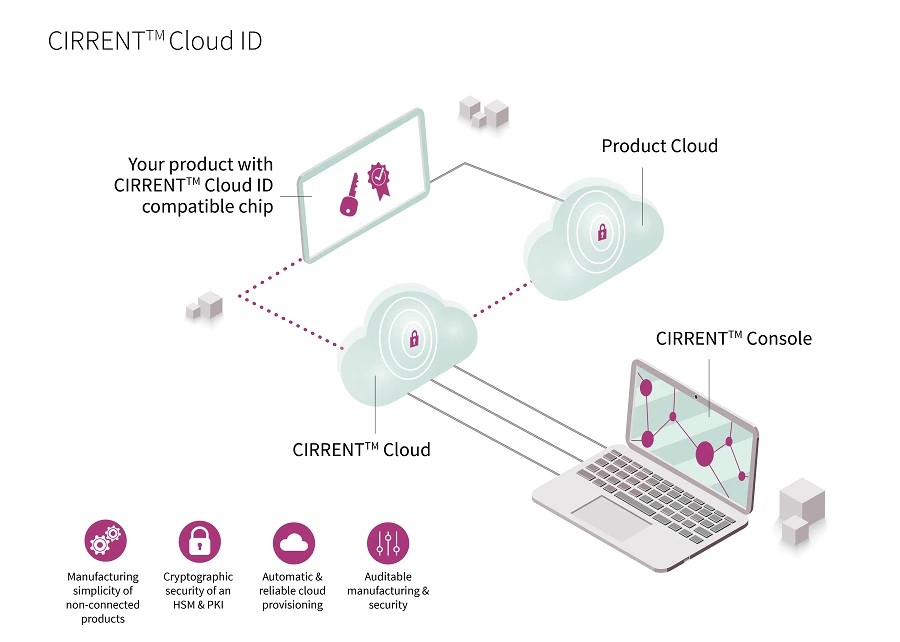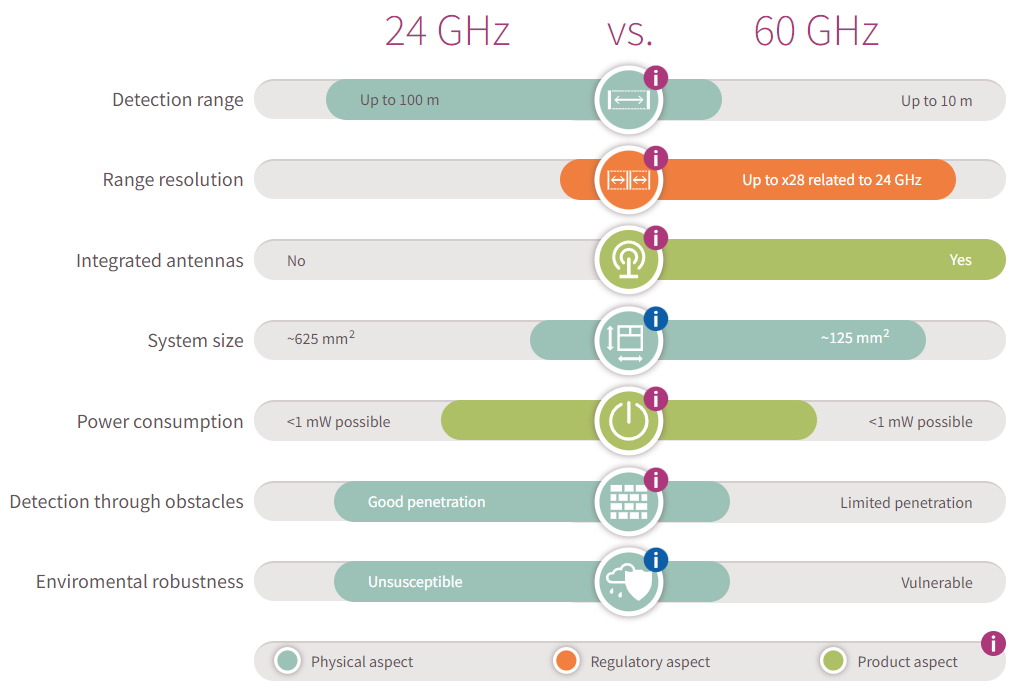
Radar offers a host of advantages over passive infrared (PIR) technology in motion detection applications. These include greater accuracy and more precise measurement of detected objects, paving the way for new capabilities in speed detection and motion sensing. These advanced capabilities enable many consumer goods such as robots, cars, smart home devices, and even lights to “see” their surroundings and respond dynamically.
Designed to support a wide range of industrial, consumer and automotive applications, Infineon’s millimeter wave (mmWave) radar portfolio offers both FMCW as well as Doppler radar sensors supporting 24GHz, 60GHz, 77/79 GHz.
Additionally, Infineon offers the smallest 24GHz Monolithic Microwave Integrated Circuits (MMICs) in the market. Thanks to the broad portfolio of automotive qualified 24GHz, 60GHz, and 77/79 GHz front-end radar MMICs (RASIC™), a full range of application can be supported from safety-critical applications such as automatic emergency braking up to driver assistance systems.
Infineon’s radar sensor portfolio includes 24GHz, 60GHz, as well as 77/79 GHz mmWave radar sensors, serving a wide range of automotive and IoT applications. Most commonly, radar sensors are used in motion detection triggering systems such as indoor and outdoor lighting solutions, automatic doors, camera and security systems, or smart home devices. Additionally, object detection can be ensured through the application of radar sensor and motion sensor ICs, since they can determine the direction of a moving object, speed of an object, distance, and depending on the antenna configuration, even the position of a moving object.
Key benefits include:
For more than 10 years, Infineon has been offering high-quality and reliable radar sensors for the automotive industry. Our 77GHz chips are capable of recognizing objects at ranges up to 250 meters away while our on-chip sensors allow for better calibration and monitoring of temperature, output power, and multiple monitors/supervisory circuits.
The single 77/79GHz radar platform supports all types of radar applications and offers automakers greater flexibility by offering numerous configuration parameters and on-chip monitoring functions. Infineon now also offers 60 GHz radar sensors for many different automotive applications.
Infineon’s selection of radar solutions for industrial and consumer applications includes fully integrated microwave radar motion sensors with Antennas in Package (AIP), as well as built-in detectors for motion and direction of motion. With a power consumption of less than 5mW, the radar sensors bring innovative, intuitive sensing capabilities to many applications.
Based on the developed algorithm the MMIC can serve established as well as new applications and use cases without intruding on privacy. Moreover, Infineon’s radar sensor technology offers a smart and cost-effective replacement for conventional PIR sensors in low power or battery-powered applications.
Complementing our XENSIV™ 77/79 GHz offering, we also deliver the market’s most integrated 60 GHz & 24 GHz radar transceiver family in the market
Radar sensors are an integral part of advanced driver assistance systems (ADAS) in modern cars. While radar sensors are especially vital for autonomous vehicles, they also improve safety and comfort features for drivers as well. Radar sensors for cars are typically deployed for blind spot detection (BSD), lane change assistance (LCA), collision mitigation (CM), parking aid (PA), and rear cross traffic alert (RCTA) features. Infineon offers a wide variety of automotive radar sensors including short-, mid-, and long-range radar sensors.
As part of our comprehensive XENSIV™ family of sensors, we offer a range of RASIC™ 77/79 GHz front-end radar sensor ICs specifically for driver assistance systems, such as adaptive cruise control and collision warning. Capable of detecting and recognizing objects at a range of up to 250 meters, these RASIC™ solutions enable the driver assistance capabilities required to obtain a five-star rating from Euro NCAP (European New Car Assessment Program). In fact, our 77/79 GHz SiGe RASIC™ chips lead the MMIC segment. The RASICTM 77/79GHz automotive radar support ASIL C, reducing customer R&D efforts.
Complementing our 77/79 GHz offering, we also deliver the market’s most integrated 24 GHz radar transceiver family in the market, offering board savings of around 30 percent compared with discrete lineups. These automotive radar sensors can be used to build RF front-end modules for mid- and short-range radar applications in different configurations.
Moreover, Infineon offers a highly integrated 60 GHz radar transceiver family which offers the most power and cost-effective solution for our customers. Used predominately for in-cabin monitoring systems, our 60 GHz portfolio enables our customers to achieve multiple functionalities by using a single 60 GHz radar setup. For instance, these sensors allow for the development of child presence detection inside the car which is a safety relevant feature to protect children from being locked and left behind resulting in a dangerous health risk scenario. Seat belt reminders are another add-on feature which is enabled by our 60 GHz radar products.
Automotive radar sensor product portfolio
For over 10 years, Infineon has been delivering reliable automotive radar sensor solutions. Our wide range of radar transceiver ICs (RASIC™) addresses the needs of 77/79 GHz radar for all safety-critical applications from automatic emergency-braking (AEB) to high-resolution radars in automated driving. It supports fast ramps for precise distance measurement and simultaneous transmitter operation for MIMO.
Infineon offers a complete suite of 77/79 GHz radar chipsets consisting of:
› Radar 77/79 GHz RF Millimeter Wave IC family (RASIC™ RXS816xPL)
› Radar MCU family featuring radar signal processing units (2nd generation AURIX™ TC3xx)
› Radar system power supply with numerous safety functions (TLF3068x)
› Very compact 3-chip configuration (RXS816xPL+ AURIX™ TC3xx + TLF3068x) for e.g. AEB sensor
Automotive radar sensor applications
Automotive radar sensors are mainly used on the body segment. They can be used for position sensing, motor control, comfort features and HMI applications. There are different categories of automotive radar sensors that designed to meet specific needs: Short-Range Radar (SRR), Mid-Range Radar (MRR), and Long-Range Radar (LRR).
Generally, short-range radar systems are used for automotive applications in which the car is moving slowly or an obstacle is located near the vehicle such as in blind spot detection sensors or lane change assist radar sensors. Using millimeter-wave radar sensors in vehicles allows the radar system to transmit electromagnetic wave signals that can then be recaptured and used to determine the range, velocity, and angle of an object when the wave signal is reflected by an object in its path.
Both short- and mid-range radar sensors can also be placed on all four corners of the vehicle. This is called a corner radar and can detect obstacles or pedestrians before they are visible to the driver and deploy automatic emergency braking (AEB). Long range radar sensors are most commonly used in the front section of vehicles as they can better detect traffic changes from farther distances ahead. As sensor content is expected to grow further as interior and comfort is becoming a key differentiation factor for OEM’s, automotive radar sensor manufacturers require high quality and reliable radar sensor technology to meet their specific needs.
Additionally, 4D automotive imaging radar sensors are increasingly being used in autonomous vehicle designs as they offer excellent detection of both moving and stationary objects from greater distances and with better accuracy than traditional radar sensors. This is due to utilizing a multi-input, multi-output (MIMO) 48-antenna array which, when compared to less than 5 transmitting and receiving antennas in regular radar sensing solutions, allows a dataset to be created of the car’s surroundings.
Using radar sensors for automotive collision warning and avoidance is especially important for automated driving where vehicles need to be able to react and reliable avoid hitting objects and people.
XENSIV™ 24GHz and 60GHz radar sensing solutions for industrial and consumer applications – small, accurate, precise
Radar sensors for IoT subcategories
As market leader in radar chips, Infineon offers a wide portfolio of mmWave radar sensors as part of the XENSIV™ sensor family – including Doppler radar as well as FMCW radar systems. This portfolio includes the smallest 24GHz MMIC in the market, as well as the largest and most integrated 24GHz radar transceiver family currently available.
These industrial radar sensors serve industrial and consumer as well as smart home applications. For example, Infineon’s 60GHz radar sensor BGT60TR13C is implemented in the Google Pixel 4 smartphone.
Motion detection with radar sensors offers significant advantages over PIR and other motion sensing technologies
With Infineon’s 24GHz and 60GHz radar portfolio a wide range of application can be covered. For instance, motion detection triggering systems such lighting solutions, automatic doors, camera and security systems, or smart home devices can be developed with Infineon’s radar sensor solutions.
In contrast to other motion detection technologies like PIR, radar technology offers significant advantages. These include smaller system sizes, greater accuracy, and more precise measurements of detected objects. For example, using 24GHz radar sensors for drones improves soft landing and obstacle avoidance. Additionally, IoT radar sensors can also determine the direction of a moving object, speed of an object, distance and, depending on the antenna configuration, even the position of a moving object.
When to use 24GHz or 60GHz radar technology
In the radar 24GHz range, the bandwidth for FMCW radar operations covers 250MHz within the regulated ISM band. In the radar 60GHz regime, an unlicensed ultra-wideband of up to 7GHz can be used for short-range applications. Consequently, 60GHz FMCW IoT radar systems can offer a better resolution and therefore allow additional use cases such as human tracking and segmentation. Even gesture sensing, material classification, or the monitoring of various vital functions (respiration, heartbeat, or even blood pressure) is possible with IoT radar technology due to micro motion detection.

Copyright © 2021 H2TC - Thiết kế bởi Giáp Phạm